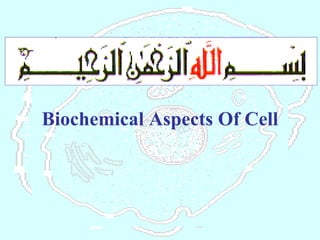Cell
•Transferir como PPS, PDF•
5 gostaram•2,126 visualizações
The document discusses key aspects of cell biochemistry and structure. It summarizes that the cell is the basic structural and functional unit of all organisms, and is made up of a membrane, nucleus, cytoplasm and organelles. The main organelles, including the mitochondria, endoplasmic reticulum, ribosomes, Golgi apparatus and lysosomes are described along with their specific functions in cellular processes like respiration, protein synthesis, packaging and secretion, and digestion. Cellular functions require energy generated through metabolic pathways that take place within these organellar compartments and the cytosol.
Denunciar
Compartilhar
Denunciar
Compartilhar

Mais conteúdo relacionado
Mais procurados
Mais procurados (20)
Proteins , INTRODUCTION, GOOD PROTEINS, BAD PROTEINS, STRUCTURE OF PROTEINS, ...

Proteins , INTRODUCTION, GOOD PROTEINS, BAD PROTEINS, STRUCTURE OF PROTEINS, ...
Carbohydrate metabolism & Interconnection of Metabolism with Respiratory chain

Carbohydrate metabolism & Interconnection of Metabolism with Respiratory chain
Destaque
Destaque (20)
Biology Form 5 Chapter 2 - Locomotion & support : 2.1 Part 1

Biology Form 5 Chapter 2 - Locomotion & support : 2.1 Part 1
Biology Form 5 Chapter 2 - Locomotion & support : 2.1 Part 2

Biology Form 5 Chapter 2 - Locomotion & support : 2.1 Part 2
Semelhante a Cell
Semelhante a Cell (20)
Cell
- 1. Biochemical Aspects Of Cell
- 10. Tissue Cell Organs System
- 17. Cytosol is the Fluid component of Cytoplasm Excluding Organelles and the Insoluble Components.
- 39. Mitochondrion Matrix Inter Membrane Space Outer Membrane Inner Membrane Folded Inside To Form Cristae
- 40. Mitochondrion Energy yielding metabolic processes Biological Oxidation (Respiratory Chain). Oxidative Phosphorylation. Citric Acid Cycle. Oxidation of Fatty Acids. CO, CN and other deadly Poisons cause Death because they block the energy yielding reactions in Mitochondria.
- 41. Cut Section of Mitochondrion
- 47. Endoplasmic Reticulum is Interconnected Network of branching canals and vesicles
- 48. Endoplasmic Reticulum is Interconnected Network of: Tubules Vesicles Sacs (Cisternae)
- 59. Golgi Apparatus (Golgi Body or Golgi Complex) Network of membranous tubules and vesicles present in most living cells
- 62. Lysosomes are Small and Simple Membranous Sacs, Contain Digestive Enzymes. Membrane Enzymes
- 92. Vacuoles A number of small cavities in the cytoplasm of a cell, bound by a single membrane and containing water, fat, or metabolic waste.